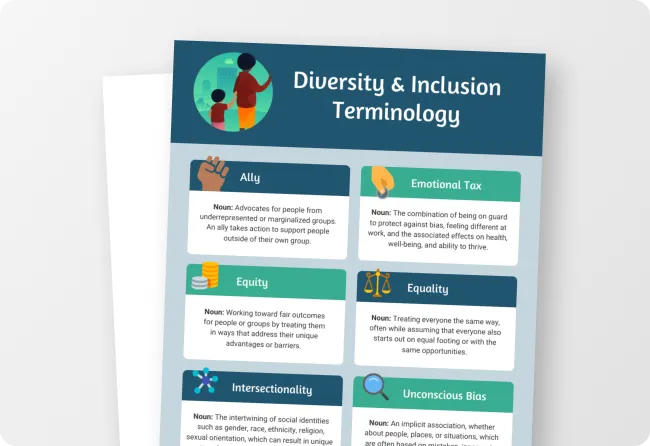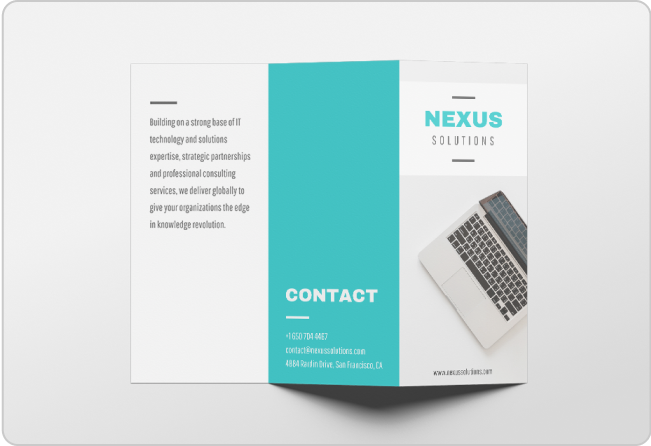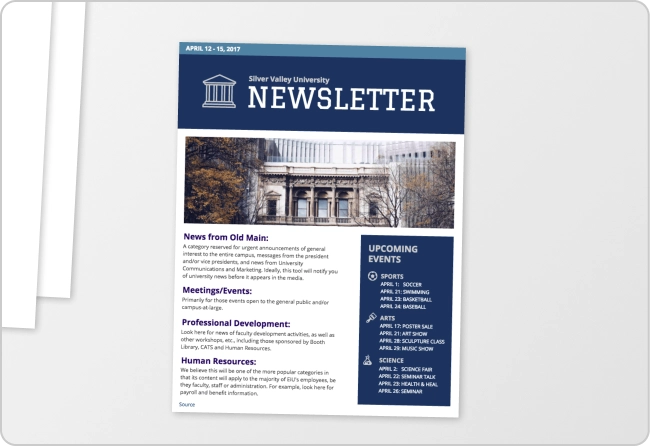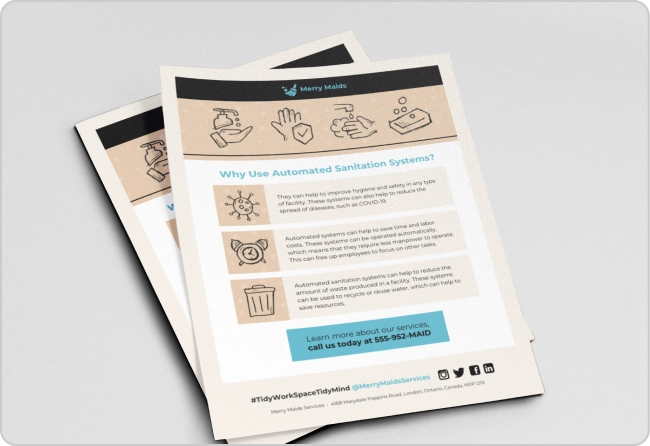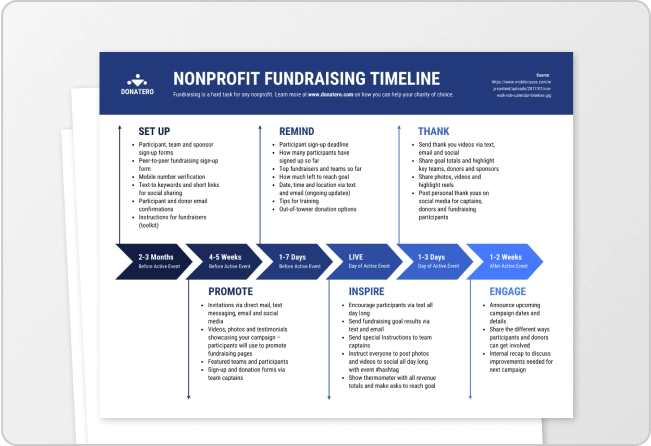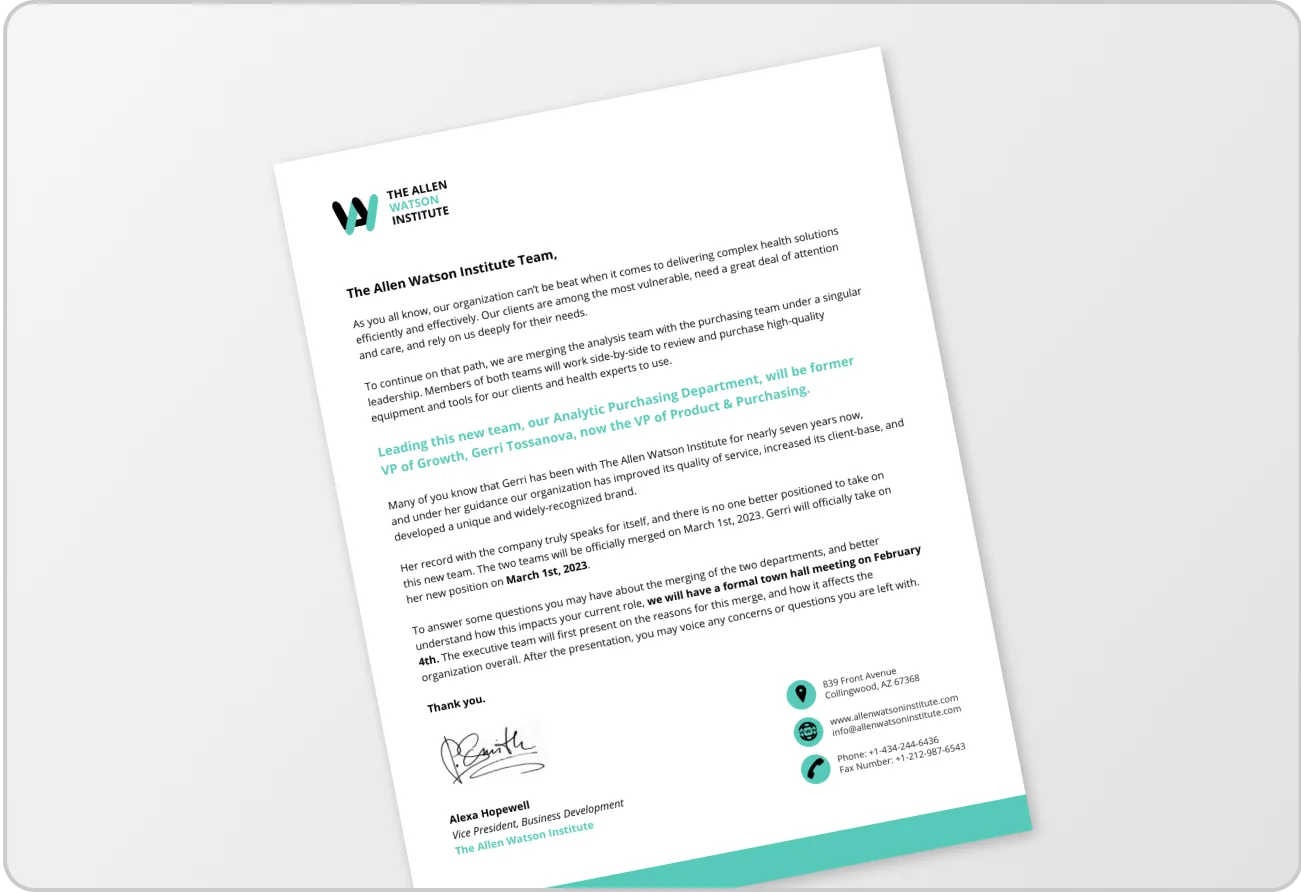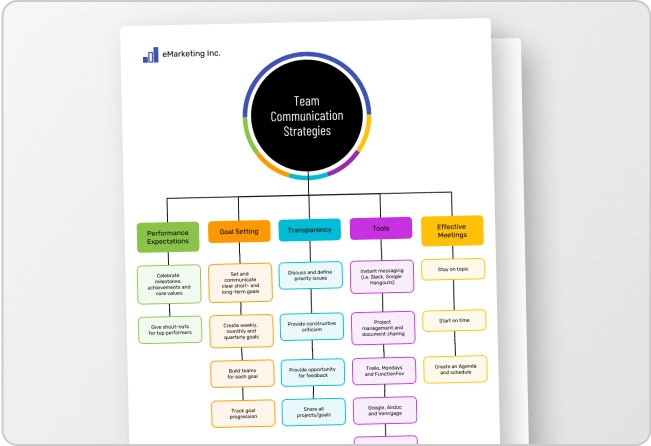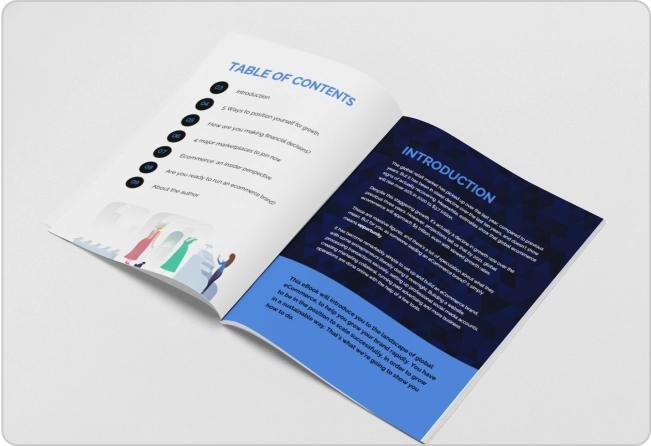
You have a great project idea for a client or need funding for your research. No matter the project, one thing is essential — a solid project proposal. It gives stakeholders a clear view of your goals, approach, and impact, increasing your chances of approval.
Creating a good project proposal is more than just a timeline and a budget. Adding visual flourishes like charts, graphs and other imagery can help elevate a boring proposal to the top of the pile. Learn how you can create a successful project proposal using an AI proposal generator and take a look at several project proposal templates you can fully customize using Venngage.
What is a project proposal?
A project proposal is a formal document that outlines the details, objectives and scope of a proposed project.
Depending on the industry and type of project proposal (more on that in a moment), these documents can include things like scope of work, timelines, staffing, budget, capability statement and more.
Companies that receive project proposals from other firms or individuals use these documents to narrow down their options and make an informed decision about the best partner for them. And companies that create project proposals use them to pitch their services of product to a prospective client.

It’s important to note that project proposals are not the same as business proposals, though there are some similarities. One of the biggest differences is that business proposals tend to be more general and expansive.
Related: Learn more about writing a great business proposal.
Types of project proposals
Let’s see the different types of project proposals and when you should create them:
Solicited proposals
Solicited proposals mean Request for Proposal (they may also be called Request for Quotation, or RFQ). They typically come with the most stringent requirements and obligations. The hiring company will usually list out the elements that must be included in the RFP as well as any limitations or conditions that apply.
From the vendor’s standpoint, being asked to submit an RFP is generally a good sign because it means that your firm (or yourself, if you’re an individual) has made it through the initial round of research by the hiring party.
Unsolicited proposals
Also called spec (speculative) proposals, unsolicited project proposals come from the vendor’s side rather than the hiring party.
These proposals are particularly difficult because the hiring party, well, may not be hiring at all. With a spec or unsolicited project proposal, the vendor believes there’s a need for their services and must not only convince the hiring party that the need exists, but that the vendor is the best one to fill that need.
Informal proposals
Informally solicited project proposals are similar to RFPs or formally solicited proposals in that they may have just as many requirements, but because they’re outside of the formal RFP process, the requirements often aren’t stated up front. That could mean the vendor needs to do more research and ask more questions of the hiring party, or it could mean there actually aren’t as many requirements.
Another benefit of submitting an informally solicited project proposal is that the absence of a formal process likely means the vendor will be up against less competition.
Renewal proposals
Renewal proposals are similar to continuation proposals, but instead of being created in the middle of a project, a renewal project proposal is generated once a project or contract has ended. They’re also called competing proposals because the vendor will need to make their case as to why the project or contract should be renewed.
It may be wise to approach these types of proposals as you might an unsolicited one, but the benefit to the vendor is that (if the project has been a success), they will have past results with that specific client to showcase in their new proposal.
Continuation proposals
Continuation proposals are common in multi-year projects or ones in which both parties may have agreed to certain conditions governing how the project proceeds.
With a continuation proposal, the goal isn’t to pitch your services but rather to keep the client up to date on the project, inform them of any metrics they need to know or that may be part of the scope of work and get their formal approval to continue with the project.
Supplemental proposals
These are additional proposals that you send the client after the initial proposal is accepted. In case the client needs more information or the project scope has changed and you need to offer additional services to the client, you can send a supplemental proposal
Key components of a project proposal?
The content of project proposals will vary depending on the industry and the type of proposal. For example, while solicited, unsolicited and pre-proposals will typically include a budget that is negotiable, a continuation proposal’s budget has likely already been set. That said, here are the typical contents of a project proposal:
1. Executive summary: An executive summary or project background is typically the first section of a project proposal. Most vendors use this as an opportunity to thank the hiring company for the opportunity, as well as summarizing what the client is about to see through the remainder of the proposal.
This template shows a complete executive summary for a product launch, which can be longer than a typical executive brief or project background in your proposal — something to keep in mind:

2. Project background: An explanation of what needs to be done in the project or what problem can be solved if the hiring party accepts the proposal. This section focuses on market trends, business requirements and overall project need.
3. Project objectives and goals: Next comes the project objectives section where you outline the specific goals you want to achieve on project completion.

4. Project scope and methodology: A detailed description of what exactly would be done, when and how much it would cost. It also includes a detailed description of project strategy and the tool and techniques that’ll be used to carry out the project.
This section may also need to include legal information, though in most cases, contracts are separate from project proposals.
Here’s an example of how you can write down the scope of work for your proposed project:

5. Timelines and milestones: You also need to explain the complete project schedule with key phases, deadlines and checkpoints.
6. Budget and resource allocation: The project proposal should include the total project budget and a detailed breakdown of all the costs involved. That’s not it! Describe briefly how you’ll allocate the budget to different resources, including personnel and technology.
7. Risk assessment and mitigation strategies: A project proposal should also account for potential risks, such as budget constraints, natural disasters and timeline delays. List down strategies on how you will identify potential risks and mitigate them.
8. Evaluation and success metrics: Measuring success ensures the project stays on track and delivers expected outcomes. Key performance indicators (KPIs) might include on-time completion, budget adherence, user adoption rates, or customer satisfaction. Regular reporting and stakeholder feedback help assess progress and make necessary adjustments.
How to write a project proposal?
Writing a great project proposal can be a challenge. That’s because you need to craft the message specifically for the company or individual you’re sending the proposal to. Before diving into the details, consider whether your project involves software or testing needs. Mentioning relevant test automation tools can strengthen your proposal.
But don’t worry if you don’t know where to start, here’s how you write an effective project proposal:
Step 1: Review the RFP (if you have one)
If there is no formal RFP, you’ll still need to start out researching as much as you can about your potential client. That means finding out not only about the problem you’re hoping to solve but the history of the client, their industry, their competitors and more. Getting to know them better will help you understand how to portray yourself or your company in the best light.
Step 2: Create a project proposal outline
Whether you use the sections we listed above in that order, add or remove ones or shift things around, jot down a quick outline of sections to keep in mind as you work.
Step 3: Define the problem and present your solution
Kick things off by clearly nailing down the problem or need your project is tackling. Back it up with some hard evidence and data to show why this issue is a big deal. Break it down for your audience, explaining how your project is going to make their lives better.
Step 4: Highlight elements that may set your proposal apart
For example, if you know that your company will be able to complete the task more quickly than any competitors, make that the focus of your solution or scope of work section. Compare your proposed timeline with what your competitors are likely to propose to the client.
You should also make notes of any elements that you might be able to visualize through a graph, chart or other design element — visuals can help not only make your project proposal easier on the eyes, but they can make it more memorable and illustrate to the client that you are able to think creatively.
Here’s an example of how it can look in your project proposal:

Step 5: Define project deliverables and goals
A rock-solid project hinges on clarity, and that starts with laying out precisely what your project will deliver. Whether it’s reports, shiny new products, or top-notch services, make it crystal clear from the get-go.
Next, set the bar with measurable goals and objectives that scream success. Break them down so everyone’s on the same page. And because time is money, map out a timeline that’s not just a bunch of dates but a roadmap with key pit stops.
These milestones and deadlines are the heartbeat of your project, guiding you through each phase and making sure you hit the finish line with style. It’s all about setting the stage for success and making sure everyone’s got their eyes on the prize.
Step 6: State your plan or approach
Now, we’ve made it to the meat of your project proposal. In this section, walk your readers through the nitty-gritty of your project management approach, including the project management software you’ll use to streamline workflows, track progress, and ensure seamless collaboration.
Break down the essentials when it comes to resources—think people, equipment, and budget. And, while you’re at it, clue them in on your game plan for handling potential challenges through your risk management strategy. Additionally, consider your approach to project management, for example agile project management prioritizes flexibility and adaptability in order to effectively respond to changes and deliver successful outcomes.
Step 7: Outline your project schedule and budget
Crafting a successful project hinges on meticulous planning, starting with the creation of a detailed project schedule.
Break down the project into specific tasks and assign realistic timelines to each one. This step-by-step schedule, like a roadmap, not only helps in visualizing the project’s progression but also aids in resource allocation and risk management.
Simultaneously, developing a comprehensive budget is paramount. Dive deep into identifying and estimating all project costs, including personnel, materials equipment, and any potential contingencies. The budget acts as the financial backbone, ensuring that resources are allocated judiciously.
But here’s the deal – keep it real. Your schedule and budget need to be doable, considering the real-world factors at play. It’s all about laying the groundwork for success and keeping everyone in the loop from start to finish.
Step 8: Write the executive summary
The executive summary serves as the project’s sneak peek, condensing the entire proposal into a punchy snapshot. This opening act isn’t just a formality; it’s your chance to grab the reader’s attention from the get-go.
Picture it like the movie trailer – it needs to be compelling, leaving the audience eager for the full feature. In this compact summary, shine a spotlight on the critical elements of your proposal.
Outline the problem you’re tackling, showcase your ingenious solution, spell out the perks and benefits and throw in a quick glance at the budget for good measure. It’s your project’s elevator pitch, setting the stage for what’s to come and making sure your audience is hooked right from the first line.
Step 9: Proofread and edit
Before sending your proposal out into the world, give it a thorough once-over. Take the time to meticulously proofread every nook and cranny, hunting down grammar slip-ups, punctuation quirks and sneaky spelling errors.
A second perspective can catch things you might have overlooked. And let’s talk presentation – ensure your proposal isn’t just a content champ but looks the part too. Format it like a pro, making sure it’s visually appealing and easy on the eyes.
After all, a polished proposal not only communicates your ideas effectively but also leaves a lasting impression. Browse Venngage’s selection of project proposal templates to get a head start today!
Additional tips:
Avoid overly salesy language
It can be tempting, particularly if you’re sending unsolicited project proposals, to use some of the same language in your proposal as you might in an ad, but you should keep such wording to a minimum.
Let the proposal speak for itself; if you or your firm truly are the best one for the job, it should be evident in your proposal. Being straightforward can also signal to the hiring party that you don’t want to waste their time with flowery language. It’s better to deal in facts rather than opinions for project proposals.
Establish a single point of contact
Some project proposals will include lists or even short bios of your staff members who will be involved in the project. But it’s a good idea to ensure that your project proposal makes it clear whom the client should contact to move the project forward or submit any questions. Include this person’s information at the beginning and the end of your document.
Write with one voice
While it’s common for large RFPs to be completed by many people on the team, ensure that whoever is responsible for bringing it all together has a chance to make the document feel cohesive. It should read as if one person put the entire thing together.
5 project proposal examples with templates
Now that we’ve explored some of the background and purpose of project proposals, let’s take a look at some templates you can customize using Venngage for your own project.
Real-world project proposal example
Here is a real-world project proposal example for developing a mobile gaming application.
Title: Development of Mobile App for XYZ Gaming Company Ltd.
Executive Summary
This project proposes the development of a mobile gaming application for XYZ Gaming Company Ltd. to provide a convenient platform for customers to browse, purchase, and download digital games directly from their mobile devices. The app will help the company enhance customer experience and streamline gaming-related purchases.
By launching this app, XYZ Gaming expects to boost mobile-based transactions by 40% in the first year, while also improving customer retention through personalized marketing and in-app promotions.
Introduction
XYZ Gaming Company Ltd. is a new brand in the gaming industry who wants to offer mind games for kids and young adults. As mobile usage continues to dominate, especially among the gaming demographic, there is a need for a dedicated mobile app to provide an enhanced gaming experience. This app will serve as a one-stop solution for game purchases and updates.
Objectives and scope
- Develop a user-friendly mobile app for Android and iOS to offer seamless browsing, purchasing, and downloading of digital mind games.
- Integrate a loyalty program and personalized game recommendations to increase customer engagement.
- Implement multiple secure payment gateways, including options for in-app purchases and digital wallets.
- Enable the app to provide real-time updates on game releases, promotions, and gaming events.
- Ensure user retention and engagement through push notifications, in-app promotions, and personalized content.
Methodology
- App design and development: Design a visually appealing, fast, and easy-to-navigate app.
- Core features: Include features such as, puzzle challenges and brain teasers with varying difficulty levels, daily mind training exercises and progress tracking and in-app hints and rewards system for completing tasks.
- Testing and security: Extensive app testing using test automation tools will ensure the app runs smoothly across all devices.
- Launch: The software development team will conduct final testing, address any last-minute bugs, and deploy the mobile app to app stores.
Budget
Here is the estimated cost for this project:
- App Development (iOS & Android) – $35,000
- UI/UX Design – $10,000
- Backend API Integration – $15,000
- Security & Testing – $5,000
Total cost – $65,000
Conclusion
The development of a mobile e-commerce app for XYZ Gaming Company Ltd. is a strategic move that will allow the company to capture a larger portion of the gaming market and increase mobile-driven sales. It will enable XYZ Gaming to remain competitive and grow its presence in the mobile gaming market.
Construction project proposal examples
The construction industry is a complex one, and project proposals are critical for landing business and keeping projects on track. But there are many approaches a construction project proposal can take.
Taking the complicated and making it simple is a challenge, particularly in this field, but as this project proposal example shows, it can be done. By using simple, clear language and well-placed visual emphasis, this free project proposal template stands out for its simplicity.

Many hiring companies simply skim project proposals for things like budget and timeframe, and while you still need to craft an engaging proposal, it’s a good idea to put those types of elements front and center, as this construction project proposal does.

Remember that regardless of whether your firm is hired for the job at hand, every document you send to another business is a chance to establish your company’s brand identity. Use a template like the one below, update it with your logo and brand colors and fonts to keep it aligned with your messaging.

As you can see from the example below, a few color changes can make a huge difference:

To easily apply your brand colors and logos, simply have them automatically extracted from your website using Autobrand:

And apply them to your design in one click with My Brand Kit:

Design project proposal examples
You might think it would be a no-brainer for a designer to create a well-designed project proposal, but it’s common for creative people to have difficulty when it comes to analytical thinking. That’s why having a couple of great project proposals in your back pocket is perfect for a designer.
Project proposals in creative fields tend to be a bit less buttoned-up than those in other industries, so use your proposal as an opportunity to make a bold design statement. The template below, for example, uses a striking color palette and minimalist imagery on the cover to make the proposal stand out, and those touches are reinforced throughout the document.

This example, similarly, uses creative color combinations to strike a design-forward tone. But as both of these templates illustrate, the bones of the project proposal must be sound, and all the information required should still be covered.

Work project proposal examples
Not every industry requires a unique approach to project proposals, and, in fact, for most applications, a general work proposal template will suffice, provided that you do your due diligence in following any requirements set forward by the hiring party.
This template created for a consulting firm illustrates a straightforward approach to project proposals that you can easily adapt for your needs. Add or remove pages, insert charts and graphs or new icons and craft a compelling narrative.

This project proposal template is an excellent example of how companies can use established templates to create a unique proposal. Note how they’ve used the sections that apply to them and put them together in a way to appeal to their potential client.

Marketing project proposal examples
Marketers and marketing agencies are regularly asked to submit RFPs, whether for individual projects or long-term engagements, so the average marketing agency will need to have several project proposals on hand that they can modify when new requests come in.
This social media marketing project proposal template is ideal for a single campaign rather than a multi-year engagement. In that situation, it’s crucial to make sure all dates and milestones in the campaign are clearly stated.

Ideally, a marketing agency or marketer will get a chance to pitch for long-term work. In that case, this project proposal template is ideal for outlining all aspects of the project proposal, including a timeline that extends to a full year.

A critical aspect of modern marketing success is doing a great deal of research on keywords, competitors and traffic, and many marketers include such metrics in their project proposals, along the lines of this example. Note how high-impact charts and graphs are used to help the audience absorb the data and make an informed decision. There are various marketing proposal examples that you can look at to inspire your next proposal design and help catch the attention of your clients.

Common mistakes to avoid in project proposals
Creating project proposals requires a structured process. Start with the industry research, list client’s pain points, outline project objectives and come up with efficient project strategies. However it’s not as straightforward as it looks.
Here are some of the common mistakes people make while creating project proposals:
- Vague problem statement and objectives: A vague or overly broad proposal can confuse stakeholders. Keep objectives, scope, and deliverables well-defined.
- Not addressing client’s requirements: A generic proposal serves no purpose. You should tailor your proposal to explain how well you understand the client’s pain points and what strategies you will use to resolve them.
- Lack of risk assessment section: Many professionals overlook the need for risk assessment and mitigation. This can result in budget overruns and project delays.
- Vague success metrics: Without clear KPIs, it’s hard to measure project impact. Define how success will be tracked and evaluated.
- No call to action: A strong proposal should clearly outline the next steps, whether it’s approval, funding requests, or scheduling a follow-up meeting
Project proposal FAQs
What is the difference between project proposals and business plans?
A project proposal focuses on a specific project, outlining its goals, scope, timeline, and resources needed to gain approval or funding. A business plan, on the other hand, is a comprehensive document that details an entire business’s objectives, strategies, financial projections, and long-term growth plans.
How long should a project proposal be?
The length depends on the complexity of the project. A simple proposal can be 5-6 pages, while larger, more detailed proposals may range from 10–20 pages. The key is to be concise yet comprehensive, ensuring all critical details are covered without unnecessary filler.
Who should write a project proposal?
The proposal should be written by someone with a clear understanding of the project, such as a project manager, team lead, or department head. In some cases, grant writers or business development professionals may draft proposals, especially when seeking external funding.
What is the best way to get a proposal approved?
To increase approval chances, align the proposal with stakeholder priorities, present clear benefits, and back up claims with data. A well-structured, visually appealing document with a strong call to action also helps. Engaging decision-makers early and addressing potential concerns proactively can further strengthen the case.
Download free project proposal templates
Letting a potential customer know what you’re capable of is a critical tool in many fields, and project proposals can highlight your company in a way few other documents can.
Start with one of these templates or create your project proposal from scratch. Whether your company has just gotten an RFP or you want to land that big fish in your industry, Venngage’s AI Proposal Generator makes it simple to create an effective project proposal without becoming overwhelmed. It’s free to get started.






























